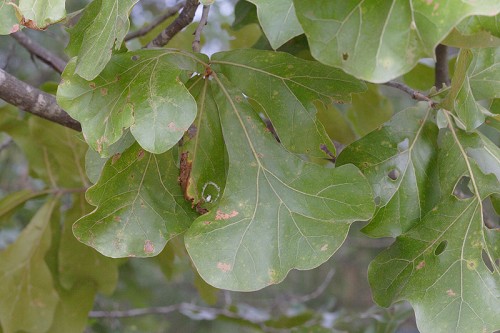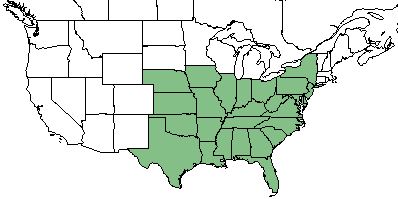Quercus marilandica
| Quercus marilandica | |
|---|---|

| |
| Photo by John Gwaltney hosted at Southeastern Flora.com | |
| Scientific classification | |
| Kingdom: | Plantae |
| Division: | Magnoliophyta - Flowering plants |
| Class: | Magnoliopsida - Dicots |
| Order: | Fagales |
| Family: | Fagaceae |
| Genus: | Quercus |
| Species: | Q. marilandica |
| Binomial name | |
| Quercus marilandica Munchh | |

| |
| Natural range of Quercus marilandica from USDA NRCS Plants Database. | |
Contents
Taxonomic Notes
Synonym: Quercus neoshei (Bush)
Variety: Quercus marilandica Muenchhausen var. ashei Sudw.; Quercus marilandica Muenchhausen var. marilandica
Description
Q. marilandica is a perennial shrub/tree of the Fagaceae family that is native to North America.[1]
Distribution
Q. marilandica is found throughout the eastern United States; as far north as New York and as far west as Texas.[1]
Ecology
Habitat
Common habitats include upland forests and woodlands. It prefers droughty soils of clay, deep sands, or sandstones.[2]
Q. marilandica has been known to have a high tolerance to drought but it is not tolerant of shade.[1] Q. marilandica has neither a significant positive or negative response to agricultural-based soil disturbance in South Carolina coastal plains communities.[3] When exposed to soil disturbance by military training in West Georgia, Q. marilandica responds negatively by way of absence.[4]
Phenology
Blooms typically occur during the mid spring and seeding in the fall.[1]
Fire ecology
Q. marilandica has a low tolerance for fire.[1]
Conservation, cultivation, and restoration
Cultural use
Photo Gallery
References and notes
- ↑ 1.0 1.1 1.2 1.3 1.4 USDA Plant Database
- ↑ Weakley, A. S. (2015). Flora of the Southern and Mid-Atlantic States. Chapel Hill, NC, University of North Carolina Herbarium.
- ↑ Brudvig, L.A., J.L. Orrock, E.I. Damschen, C.D. Collins, P.G. Hahn, W.B. Mattingly, J.W. Veldman, and J.L. Walker. (2014). Land-Use History and Contemporary Management Inform an Ecological Reference Model for Longleaf Pine Woodland Understory Plant Communities. PLoS ONE 9(1): e86604.
- ↑ Dale, V.H., S.C. Beyeler, and B. Jackson. (2002). Understory vegetation indicators of anthropogenic disturbance in longleaf pine forests at Fort Benning, Georgia, USA. Ecological Indicators 1(3):155-170.